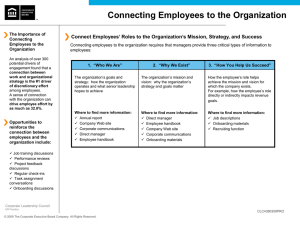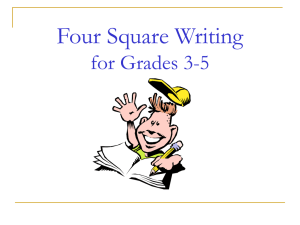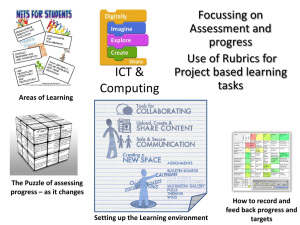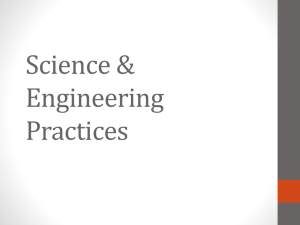powerpoint lecture
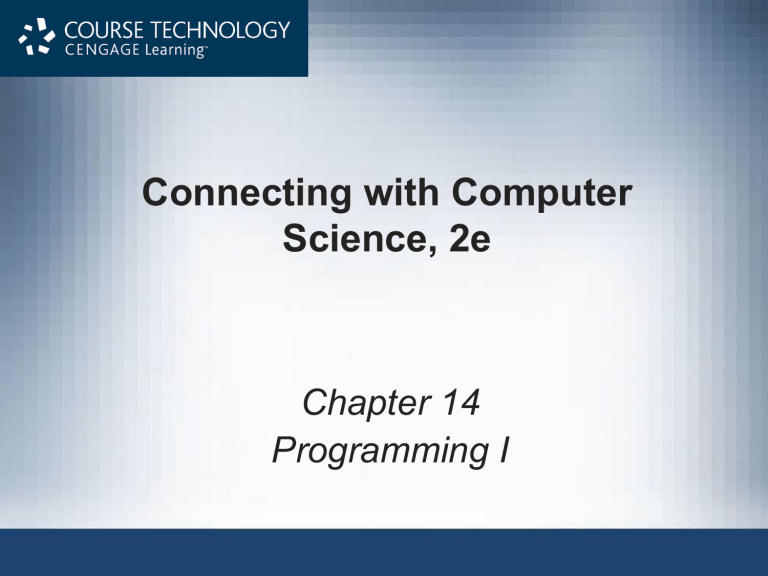
Connecting with Computer
Science, 2e
Chapter 14
Programming I
Objectives
• In this chapter you will:
– Learn what a program is and how it’s developed
– Understand the difference between a low-level and high-level language
– Be introduced to low-level languages, using assembly language as an example
– Learn about program structure, including algorithms and pseudocode
Connecting with Computer Science, 2e 2
Objectives (cont’d.)
• In this chapter you will (cont’d.):
– Learn about variables and how they’re used
– Explore the control structures used in programming
– Understand the terms used in object-oriented programming
Connecting with Computer Science, 2e 3
Why You Need to Know About...
Programming
• Examples of programs in everyday functions:
– Cars, space shuttles, ATMs, and microwaves
• It is important to develop a quality programming product
– People depend on it
• Programming is essential to future computing career
Connecting with Computer Science, 2e 4
What Is a Program?
• Program:
– Collection of statements or steps
• Solves a problem
• Converted into a language the computer understands to perform tasks
• Algorithm:
– Logically ordered set of statements
• Used to solve a problem
• Interpreter:
– Translates program’s statements into a language the computer understands
Connecting with Computer Science, 2e 5
What Is a Program? (cont’d.)
• Compiler:
– Application reading all the program’s statements
• Converts them into computer language
• Produces an executable file running independently of an interpreter
• Programs are developed to help perform tasks
– Communicate with users to meet their needs
• Causes of program failure:
– Piece of logical functionality left out of the program
– Contains logic errors in one or more statements
Connecting with Computer Science, 2e 6
I Speak Computer
• First step in programming
– Determine language to communicate with the computer
– Computers only speak binary
• Many choices:
– Ada, Assembly, C, C++, C#
– COBOL, FORTRAN, Delphi (Pascal)
– Java and JavaScript
– Lisp, Perl, Smalltalk, Visual Basic
• Each has its own strengths and weaknesses
Connecting with Computer Science, 2e 7
I Speak Computer (cont’d.)
• Low-level language:
– Uses binary code for instructions
• Machine language:
– Lowest-level programming language
• Consists of binary bit patterns
• Assembly language:
– One step up from machine language
• Assigns letter codes to each machine-language instruction
Connecting with Computer Science, 2e 8
I Speak Computer (cont’d.)
• Assembler:
– Program that reads assembly-language code and converts it into machine language
• High-level language:
– Written in a more natural language that humans can read and understand
Connecting with Computer Science, 2e 9
I Speak Computer (cont’d.)
Figure 14-1, Different types of programming languages
Connecting with Computer Science, 2e 10
Low-Level Languages
• Few people code in machine language
• Assembly language:
– Simulates machine language
– Written with more English-like statements
– Advantages:
• Corresponds to one machine instruction
• Programs are usually smaller and run faster than programs in higher-level languages
• Powerful
– Closely tied to the CPU type
• Assemblers written for every type of CPU
Connecting with Computer Science, 2e 11
Assembly-Language Statements
• Registers in a CPU
– Special memory locations for storing information programs can use
– Registers: AX, BX, CX, and DX
• General-purpose registers (GPRs)
• Used mainly for arithmetic operations or accessing an element in an array
• Consists of text instructions
– Converted one by one into machine (binary) instructions
• Disadvantage: hard to read and understand
Connecting with Computer Science, 2e 12
Assembly-Language Statements
(cont’d.)
• Syntax:
– Rules for how a programming language’s statements must be constructed
• mov : moves values around
– Example: move the value of 8 into the CX register
• mov cx, 8
– Can move a value from memory to a register, from a register to memory, from register to register
• mov dx, cx
Connecting with Computer Science, 2e 13
Assembly-Language Statements
(cont’d.)
• add : takes a value on the right and adds it to the value on the left
– Example: storing value of 11 in DX register
• mov cx, 3
• mov dx, 8
• add dx, cx
• inc : adds 1 to the register being used
– Example: add 1 to DX register to get 12
• inc dx
Connecting with Computer Science, 2e 14
Assembly-Language Statements
(cont’d.)
• sub : tells the assembler to subtract one number from another number
– Example: DX = DX – CX
• CX register still contains value 4
• DX register contains value 3
• mov cx, 4
• mov dx, 7
• sub dx, cx
Connecting with Computer Science, 2e 15
Assembly-Language Statements
(cont’d.)
• cmp : tells assembler to compare two values
– Result sets flag bits in the flags (FL) register
• If the result of the compare equals 0, zero (ZR) flag is set to a binary 1, and the sign (SF) flag is set to 0
• If the result of the compare is a negative number, ZR flag bit is set to a binary 0, and the SF flag is set to 1
– Example: DX – CX = 0, ZR flag is set to 1
• mov cx, 4
• mov dx, 7
• cmp dx, cx
Connecting with Computer Science, 2e 16
Assembly-Language Statements
(cont’d.)
• jnz : tests value of ZR flag maintained by the system
– If set to 1: jump somewhere else in the program
– Not set: assembler continues to process code on the next line
– Example:
• mov cx, 4
• mov dx, 7
• cmp dx, cx
• jnz stop
Connecting with Computer Science, 2e 17
High-Level Languages
• Writes programs independent of computer or CPU
• Advantages:
– Easier to write, read, and maintain
– Can accomplish much more with a single statement
– No one-to-one relationship between a statement and a binary instruction
• Disadvantages:
– Programs generally run slower
• Must be compiled or interpreted
• Examples: Java, C++, Delphi, and C#
Connecting with Computer Science, 2e 18
HighLevel Languages (cont’d.)
• Integrated development environment (IDE):
– Interface provided with software development languages
• Incorporates all tools needed to write, compile, and distribute programs
• Tools often include editor, compiler, graphical designer, and more
Connecting with Computer Science, 2e 19
HighLevel Languages (cont’d.)
Figure 14-2, An IDE makes software development easier
Connecting with Computer Science, 2e 20
Structure of a Program
• Before writing a program in any language:
– Know how the program should work
– Know the language syntax
• Formal definition of how statements must be constructed in the programming language
• Learning a programming language is similar to learning a foreign language
Connecting with Computer Science, 2e 21
Algorithms
• Help describe the method used to solve a problem
– Break down each task in the plan into smaller subtasks
• For many tasks, plan a series of logical steps to accomplish them
– Provide a logical solution to a problem
– Consist of steps to follow to solve the problem
– Convert algorithm into programming statements by representing the steps in some format
• Pseudocode is often used
Connecting with Computer Science, 2e 22
Pseudocode
• Readable description of an algorithm written in human language
– Template describing what needs converting into programming language syntax
– No formal rules for writing pseudocode
• Information should explain the process to someone with little experience in solving this type of problem
– Practice provides necessary skill
Connecting with Computer Science, 2e 23
Pseudocode (cont’d.)
Figure 14-3, A temperature conversion chart
Connecting with Computer Science, 2e 24
Pseudocode (cont’d.)
• Start with the formulas needed in the algorithm:
– Fahrenheit to Celsius: Celsius temp = (5/9) *
(Fahrenheit temp – 32)
– Celsius to Fahrenheit: Fahrenheit temp = ((9/5) *
Celsius temp) + 32
• After formulas are proved correct, begin outlining steps to write a program
– Input from the user
– Calculates the conversions
– Displays results to the user
Connecting with Computer Science, 2e 25
Pseudocode (cont’d.)
Connecting with Computer Science, 2e 26
Choosing the Algorithm
• Determine best algorithm for the project
– Example: many ways to get to Disney World
• Fly
• Drive
• Hitchhike
• Walk
– Each has advantages and disadvantages
Connecting with Computer Science, 2e 27
Testing the Algorithm
• Test before typing program code
– Pretending to be an end user who is not knowledgeable about the program
– Putting yourself in the user’s shoes helps predict possible mistakes that users might make
Connecting with Computer Science, 2e 28
Syntax of a Programming Language
• After defining an algorithm and testing the logic thoroughly, begin translating the algorithm
– May have many different ingredients:
• Variables
• Operators
• Control structures
• Objects
Connecting with Computer Science, 2e 29
Variables
• A name used to identify a certain location and value in the computer’s memory
– Program type determines variable types needed
– When a variable is defined, the data type is specified
• Advantages:
– Access memory location’s content
• Use its value in a program
– Easy way to access computer memory
• No need to know actual hardware address
• Identifier: name of a variable
Connecting with Computer Science, 2e 30
Identifiers and Naming Conventions
• Identifier used to access memory contents associated with a variable
• Items to consider when deciding on an identifier:
– Name should describe data being stored
• Use variable-naming standards
– Can use more than one word for a variable’s identifier
• Example: Sun standard
– Use meaningful names
Connecting with Computer Science, 2e 31
Operators
• Symbols used to indicate data-manipulation operations
– Manipulate data stored in variables
– Classified by data type
– One may work on numbers, and another on characters (depending on definition)
Connecting with Computer Science, 2e 32
Math Operators
• Mathematical operators:
– Addition (+)
– Subtraction (–)
– Multiplication (*)
– Division (/)
– Modulus (%)
• Returns the remainder when performing division
Connecting with Computer Science, 2e 33
Math Operators (cont’d.)
Table 14-1, Standard mathematical operators
Connecting with Computer Science, 2e 34
Increment and Decrement Operators
• Most common programming instructions
– Examples: ++ and --
– Example: increment operator takes value stored in the iCount variable (5), adds 1 to it, stores the value
6 in the iResult variable
• iCount = 5
• iResult = ++iCount
– Example: decrement operator takes value stored in the iCount variable (5), subtracts 1 from it, stores the value 4 in the iResult variable
• iCount = 5
• iResult = --iCount
Connecting with Computer Science, 2e 35
Increment and Decrement Operators
(cont’d.)
• Two types of increment and decrement operators
– Pre operator places ++ or -symbol before the variable name
• Preincrement: ++variable
• Predecrement: --variable
– Post operator places ++ or -symbol after the variable name
• Postincrement: variable++
• Postdecrement: variable--
Connecting with Computer Science, 2e 36
Relational Operators
• Main purpose is to compare values
Table 14-2, Standard relational operators
Connecting with Computer Science, 2e 37
Logical Operators
• Main function is to build a truth table when comparing expressions
– Expression: programming statement returning a value when it’s executed
• Usually use relational operators to compare variables
Table 14-3, Standard logical operators
Connecting with Computer Science, 2e 38
Logical Operators (cont’d.)
Table 14-4, Boolean expressions
Connecting with Computer Science, 2e 39
Precedence and Operators
• Precedence: order in which something is executed
• Symbols with a higher precedence executed before those with a lower precedence
– Have a level of hierarchy
• Example: 2 + 3 * 4
– Output = 14 (not 20)
Connecting with Computer Science, 2e 40
Precedence and Operators (cont’d.)
Figure 14-4, Order of relational and mathematical precedence
Connecting with Computer Science, 2e 41
Control Structures and Program Flow
• Control structure: instruction that dictates the order in which statements in a program are executed
– “Spaghetti code” results if not followed
• Four control structure types:
– Invocation
– Top down
– Selection
– Repetition
• Control structure performs a specific task
Connecting with Computer Science, 2e 42
Invocation
• Act of calling something
– Copy code for a specific task (called “functionality”) to a file and name it descriptively
– Write a new program
• “Call” (invoke) this piece of code without having to rewrite it
• Saves time and money in program development
– After piece of code used:
• Control is passed back to the original program location to continue
Connecting with Computer Science, 2e 43
Top Down (Also Called Sequence)
• Used when program statements are executed in a series
– From top line to the bottom line one at a time
– First statement executed is the first line in the program
– Each statement executed in sequential order
• Start with first line and continue until last line processed
• Most common structure
• Implemented by entering statements that do not call other pieces of code
Connecting with Computer Science, 2e 44
Selection
• Make a choice (selection) depending on a value or situation
– A standard part of most programs
Connecting with Computer Science, 2e 45
Repetition (Looping)
• Used when source code is to be repeated
• Referred to as “looping”
– Commonly used with databases or when you want an action to be performed one or many times
• Standard repetition constructs
– for
– while
– do-while
Connecting with Computer Science, 2e 46
Ready, Set, Go!
• Building blocks:
– Variables, operators, and control structures
• Use Java to show examples of programming code:
– Download Java
– Choose an editor
– Enter the program in a text file
– Compile it from the command prompt
– Run the program
Connecting with Computer Science, 2e 47
Object-Oriented Programming
• Style of programming
• Involves representing items, things, and people as objects instead of basing program logic on actions
– Object: includes qualities, what it does, and how it responds or interacts with other objects
– Distinct features:
• Characteristics
• Work
• Responses
Connecting with Computer Science, 2e 48
ObjectOriented Programming (cont’d.)
Figure 14-6, An object has characteristics, work, and responses
Connecting with Computer Science, 2e 49
ObjectOriented Programming (cont’d.)
• Alarm object features:
– Characteristics
– Work
– Responses
• High-level languages support OOP
• OOP can represent part of the program as a selfcontained object
• Advantages: reusability and maintainability
Connecting with Computer Science, 2e 50
How OOP Works
• Toy company division responsible for creating kungfu action figure
– Method one:
• Give every division employee piece of plastic
• Everyone carves the figure
– Method two:
• Create a mold (class or template in object-oriented terminology)
• Figure can be mass-produced economically and efficiently
Connecting with Computer Science, 2e 51
How OOP Works (cont’d.)
• Making the mold
– Skeleton or the basic outline of a finished product
• Defines figure’s attributes
• Creating the figure
– Pour plastic into the mold
• Different colors of plastic in different parts of the mold create attributes
• Mold defines what the plastic will be
• Putting the figure to work
– Figure can perform some work or action
Connecting with Computer Science, 2e 52
How OOP Works (cont’d.)
• Putting the figure to work (cont’d.)
– Class: mold or template for creating the figure
– Object: the figure
– Instantiation: creation process
– Constructor: method used to instantiate an object in a class
– Property or an attribute: characteristic of the figure
– Method: work performed by an object
– Event or event handler: object’s response to some action taken by the end user or system
Connecting with Computer Science, 2e 53
How OOP Works (cont’d.)
Figure 14-7, Making a plastic figure shows OOP concepts in action
Connecting with Computer Science, 2e 54
How OOP Works (cont’d.)
• Inheritance:
– Process of creating more specific classes based on generic classes
• Base (or parent) class:
– General class from which other classes can be created via inheritance
• Subclass:
– A more specific class, based on a parent class and created via inheritance
Connecting with Computer Science, 2e 55
How OOP Works (cont’d.)
Figure 14-8, Inheritance promotes code reusability
Connecting with Computer Science, 2e 56
How OOP Works (cont’d.)
• Encapsulation:
– Process of hiding an object’s operations from other objects
• Polymorphism:
– An object’s capability to use the same expression to denote different operations
Connecting with Computer Science, 2e 57
Choosing a Programming Language
• Functions to consider:
– Functionality
– Vendor stability
– Popularity
– Job market
– Price
– Ease of learning
– Performance
• Download trial versions and try for yourself
Connecting with Computer Science, 2e 58
One Last Thought
• A program does whatever the programmer tells it to do
– Blame program failure on the programmer, not the computer
• Key word: responsibility
– Programs can help society or produce serious ramifications
Connecting with Computer Science, 2e 59
Summary
• A program is a collection of statements or steps that solve a problem
– There are many language choices available
• Machine languages
• Low-level languages
• Assembly languages
• High-level languages
• Integrated development environment (IDE)
– Provides programming tools
Connecting with Computer Science, 2e 60
Summary (cont’d.)
• Program structure
– Based on algorithms
– Represented with pseudocode
• Program language syntax
– Variables, operators, control structures, and objects
– Be aware of operator precedence
– Avoid spaghetti code
– Control structures
• Innovation, sequence, selection, and looping
Connecting with Computer Science, 2e 61
Summary (cont’d.)
• Start programming:
– Obtain software package
– Choose an editor
– Write the code
– Compile and fix errors
– Run program
• Distinct features of object-oriented programming:
– Characteristics, work, and responses
– Inheritance, encapsulation, and polymorphism
Connecting with Computer Science, 2e 62

